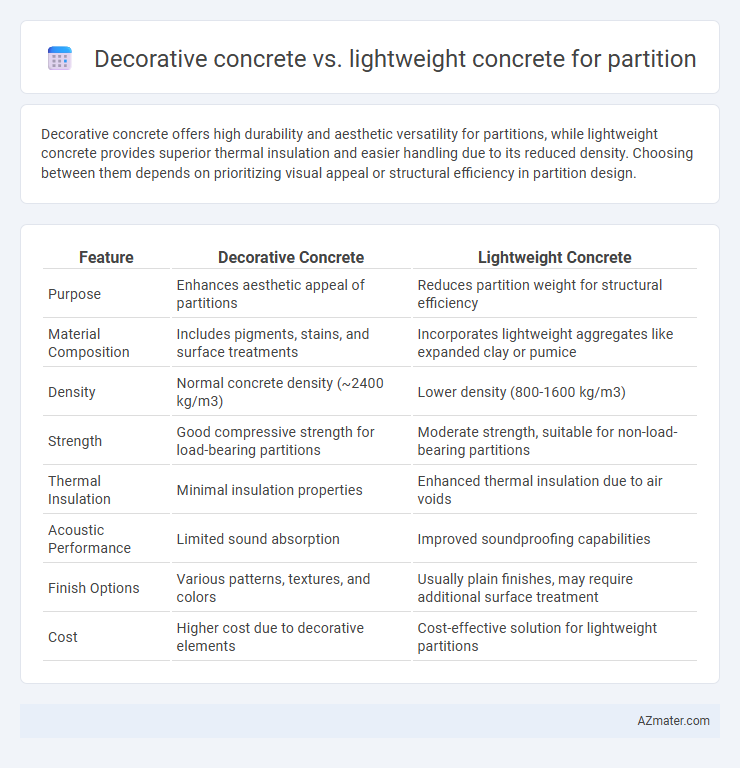Decorative concrete offers high durability and aesthetic versatility for partitions, while lightweight concrete provides superior thermal insulation and easier handling due to its reduced density. Choosing between them depends on prioritizing visual appeal or structural efficiency in partition design.
Table of Comparison
| Feature | Decorative Concrete | Lightweight Concrete |
|---|---|---|
| Purpose | Enhances aesthetic appeal of partitions | Reduces partition weight for structural efficiency |
| Material Composition | Includes pigments, stains, and surface treatments | Incorporates lightweight aggregates like expanded clay or pumice |
| Density | Normal concrete density (~2400 kg/m3) | Lower density (800-1600 kg/m3) |
| Strength | Good compressive strength for load-bearing partitions | Moderate strength, suitable for non-load-bearing partitions |
| Thermal Insulation | Minimal insulation properties | Enhanced thermal insulation due to air voids |
| Acoustic Performance | Limited sound absorption | Improved soundproofing capabilities |
| Finish Options | Various patterns, textures, and colors | Usually plain finishes, may require additional surface treatment |
| Cost | Higher cost due to decorative elements | Cost-effective solution for lightweight partitions |
Introduction to Decorative Concrete and Lightweight Concrete
Decorative concrete enhances partitions with aesthetic textures and patterns, utilizing materials like stamped overlays, stains, and dyes to create visually appealing surfaces. Lightweight concrete is produced by incorporating lightweight aggregates such as expanded clay, shale, or pumice, reducing the partition's overall weight while maintaining structural integrity. Both materials offer unique benefits for partition applications, balancing design flexibility with practical considerations like weight and durability.
Key Differences Between Decorative and Lightweight Concrete
Decorative concrete emphasizes aesthetic appeal through textures, colors, and finishes, making it ideal for visually striking partitions, while lightweight concrete prioritizes reduced weight and improved thermal insulation properties for structural efficiency. Decorative concrete incorporates aggregates, pigments, and stamping techniques to achieve artistic designs, whereas lightweight concrete uses lightweight aggregates such as expanded clay or shale to decrease density. Both materials serve distinct functional purposes: decorative concrete enhances visual impact in interior and exterior partitions, whereas lightweight concrete optimizes load-bearing capacity and energy performance in partition walls.
Composition and Material Properties
Decorative concrete for partitions typically incorporates aggregates such as quartz, glass, or colored pigments, enhancing aesthetic appeal with a dense, durable matrix often achieving compressive strengths above 40 MPa. Lightweight concrete uses expanded materials like perlite, vermiculite, or lightweight aggregates (e.g., expanded clay or shale) to reduce density, usually resulting in strengths between 10 and 30 MPa and improved thermal insulation. The lower density and porosity of lightweight concrete reduce load on structures and increase thermal efficiency, while decorative concrete emphasizes surface finish and hardness for visual impact and wear resistance.
Aesthetic Appeal of Decorative Concrete Partitions
Decorative concrete partitions offer superior aesthetic appeal through customizable textures, colors, and intricate patterns that enhance interior design versatility. Unlike lightweight concrete, which prioritizes structural efficiency and insulation, decorative concrete provides a visually striking finish that mimics natural stone, wood, or artistic motifs. This makes decorative concrete ideal for spaces seeking both functionality and distinctive, high-end visual impact.
Weight and Structural Implications of Lightweight Concrete
Lightweight concrete significantly reduces the overall weight of partitions, easing structural load and foundation requirements while maintaining adequate strength for interior walls. Decorative concrete, though heavier, offers enhanced aesthetic versatility and durability but may necessitate additional support in structural design. Choosing lightweight concrete improves seismic performance and reduces transportation costs, making it ideal for non-load-bearing partitions.
Installation Process and Ease of Construction
Decorative concrete offers a streamlined installation process with its ability to be poured and finished on-site, allowing for seamless integration of textures and colors that enhance partition aesthetics. Lightweight concrete simplifies construction through its reduced weight, decreasing the need for heavy-duty support structures and enabling faster handling and placement in partition walls. Both materials cater to efficient construction, but decorative concrete excels in customizable finishes while lightweight concrete prioritizes ease of transport and installation speed.
Durability and Maintenance Factors
Decorative concrete partitions offer high durability due to their dense composition and resistance to wear, making them ideal for high-traffic areas with minimal maintenance requirements. Lightweight concrete partitions, while easier to install and less burdensome structurally, typically have reduced strength and may require more frequent upkeep to prevent chipping and surface damage. Choosing between decorative and lightweight concrete partitions depends heavily on the desired balance between long-lasting durability and ease of handling during installation and maintenance.
Cost Comparison for Partition Projects
Decorative concrete typically incurs higher initial costs for partition projects due to specialized finishes and surface treatments that enhance aesthetics. Lightweight concrete offers cost advantages by reducing material weight and easing labor requirements, leading to lower transportation and installation expenses. Budget-conscious partition projects benefit from lightweight concrete's affordability, while decorative concrete remains preferred when visual appeal justifies the premium investment.
Acoustic and Thermal Insulation Performance
Decorative concrete offers moderate acoustic insulation but often falls short in thermal performance compared to lightweight concrete, which provides superior sound absorption and enhanced thermal insulation due to its porous structure. The cellular composition of lightweight concrete significantly reduces heat transfer and dampens noise, making it ideal for partition walls requiring energy efficiency and soundproofing. Selecting lightweight concrete partitions improves overall indoor comfort by balancing acoustic performance with thermal regulation more effectively than decorative concrete options.
Choosing the Right Concrete for Your Partition Needs
Decorative concrete offers aesthetic customization with textures and colors, making it ideal for visible partitions where design matters most. Lightweight concrete provides superior thermal insulation and soundproofing, reducing structural load and enhancing energy efficiency for functional partitions. Selecting the right concrete depends on balancing visual appeal with performance requirements, focusing on partition location, durability, and specific use cases.

Infographic: Decorative concrete vs Lightweight concrete for Partition
 azmater.com
azmater.com